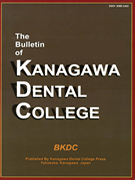- HOME
- > 一般の方
- > バックナンバー:The Bulletin of Kanagawa Dental College
- > 37巻2号
- > アブストラクト
アブストラクト(37巻2号:The Bulletin of Kanagawa Dental College)

English
| Title : | Antibacterial Activity of Denture Base Acrylic Resin Containing Apatite-coated TiO2 Photocatalyst |
|---|---|
| Subtitle : | ORIGINAL ARTICLES |
| Authors : | Takeshi Shibata*1, Katsuhiko Kimoto*1,*2, Nobushiro Hamada*2,*3, Hidefumi Kumada*3, Tomofumi Sawada*1, Tomoji Sawada*4, Minoru Toyoda*4 |
| Authors(kana) : | |
| Organization : | *1Division of Fixed Prosthodontics, Department of Oral and Maxillofacial Rehabilitation, Kanagawa Dental College, *2Research Center of Brain and Oral Science, Kanagawa Dental College, *3Division of Microbiology, Department of Infection Control, Kanagawa Dental College, *4Division of Removal Prosthetics, Department of Oral and Maxillofacial Rehabilitation, Kanagawa Dental College |
| Journal : | The Bulletin of Kanagawa Dental College |
| Volume : | 37 |
| Number : | 2 |
| Page : | 105-110 |
| Year/Month : | 2009 / 9 |
| Article : | Original article |
| Publisher : | Kanagawa Odontological Society |
| Abstract : | [Abstract] Anatase titanium dioxide (TiO2) photocatalysts are commonly used to inactivate bacteria and viruses because they are inexpensive and nontoxic. An apatite-coated TiO2 (Ap-TiO2) has recently been developed for mixing with organic materials. The purpose of this study was to develop a denture base acrylic resin with antibacterial properties by making use of the photocatalytic activity of Ap-TiO2. Acrylic resin was used as the basic resin body for the specimen plates. Resin polymers containing 0.5, 1, 5 and 20wt% of TiO2 and Ap-TiO2 powder were polymerized with the monomer. Escherichia coli (E. coil) was used in an antibacterial activity assay of the specimen plates under ultraviolet A radiation from a black light source. The viable cells were counted according to the number of colony-forming units (CFUs). All the groups that were irradiated from a distance of 10?cm showed strong photocatalytic and antibacterial action in comparison with groups irradiated from 20 cm. In the 10 cm setting group, statistically significant decreases in cell viability were observed in specimens containing 20wt% of Ap-TiO2 after irradiation for two hours (P<0.01); specimens containing 5 and 20wt% of TiO2 and Ap-TiO2 after irradiation for four hours (P<0.01); and specimens containing 0.5wt% of Ap-TiO2 after irradiation for six hours (P<0.01) when compared to the control. Furthermore, almost all E. coli in the 5wt% and 20wt% specimens were killed. Ap-TiO2 demonstrated a greater antibacterial effect than TiO2 in specimens containing 20wt% after two hours and 1wt% after six hours (P<0.01). These findings confirm that acrylic resin containing Ap-TiO2 is capable of exerting antibacterial effects on E. coli and suggest that there is significant potential for the practical use of photocatalysts in acrylic resin denture bases. |
| Practice : | Dentistry |
| Keywords : | Apatite-coated TiO2 photocatalyst, Acrylic resin, Escherichia coli, Antibacterial activity |
